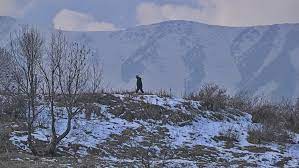Kashmir has been known as ‘Heaven on Earth’ for a long time. But, this winter has seen little to no snowfall in Kashmir. Tourism has suffered and the Khelo India Winter Games may be postponed. But the absence of snowfall could have other catastrophic consequences.
As the world warms and climate change touches every corner, the Himalayas are seeing unprecedented snow loss.
Climate change has reduced snowfall and cold days in the hills, but day and night temperatures have risen.
Snow-deprived Himalayan summits in Nepal and the Hindu Kush warn of global warming and climate change.
Weather experts hope for good snowfall before the end of the month, but the situation is dismal. Winter has been dry until mid-January 2024, with a rain deficit. January had a 100% deficit, while November had 80% and December 79%.
We may get snow in 7–8 days if the current circumstances hold. Winter length has decreased in recent years. J&K now has a winter season from December to January instead of October to March. World-wide climate change and warming are to blame. Snow is turning into rain. The Srinagar IMD Centre Head, Mukhtar Ahmed, reports snowfall has decreased.
Himachal Pradesh and Uttarakhand have comparable situations. Tourism sites famed for international ski contests are lacking snow. Higher Annapurna range altitudes have similar stories.
India Today quoted Kathmandu University Department of Environmental Science and Engineering Professor Rijan Bhakta: “This year very little winter precipitation has been witnessed in Nepal, and because of the weak Western Disturbance, there has been very little snowfall across the Himalayas.”
Professor Bhakta predicts Himalayan rain, but the delayed snowfall and weaker Western disturbance will cause a hydroecology crisis and lower winter agricultural yields. Even if precipitation is good in the next days, lateness will impair crop yield. He attributes it to climate change.
Snow covers make the Himalayan cryosphere, which is changing, unique.
“So far, northern India’s mountains have seen little snowfall. This is because Western Disturbances are feeble. “Last season, snowfall started late in December 2022 and lasted until January 2023,” says Skymet Weather Vice President of Meteorology and Climate Change Mahesh Palawat.
The Himalayas are vulnerable, according to several studies. Last October, UN Secretary-General Antonio Guterres visited Nepal and warned that Nepal had lost over a third of its ice volume in 30 years, with glaciers melting 65% faster.
The Hindukush Himalaya Assessment Report suggests that Himalayan warming over the previous 100 years has exceeded the global average of 0.74 degrees Celsius. Regional glacier retreat is caused by “precipitation decrease in combination with temperature increase.” Research shows that global warming and drying will accelerate glacier decline.
declining precipitation over the Central Himalayas is associated to increased western disturbance synoptic-scale activity, while local precipitation is declining.
The dry winter and snowless mountains in Jammu and Kashmir, Himachal Pradesh, and Uttarakhand are the most obvious signs.
“It’s a wake-up call to the complex relationship between climate and our actions, not just a periodic aberration. Prof. Anjal Prakash, Clinical Associate Professor (Research) and Research Director, Bharti Institute of Public Policy, ISB and IPCC Author, says the cold winds teach us to be resilient and sustainable.
Conclusion
Tourism and the Khelo India Winter Games may be delayed due to a Himalayan snowfall shortfall. Climate change has caused fewer cold days and higher temperatures due to less snowfall. A rain shortfall and dry winter until mid-January 2024 make the situation dire. Research shows that the Himalayan cryosphere, unique to snow coverage, is vulnerable. Western disturbances are increasing synoptic-scale activity and lowering Central Himalayan precipitation. The dry winter and snowless mountains of Jammu and Kashmir, Himachal Pradesh, and Uttarakhand call for climate resilience and sustainability.



